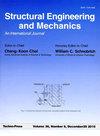基于深度CNN和模态试验数据的钢桥连接刚度折减分析
IF 2.2
4区 工程技术
Q2 ENGINEERING, CIVIL
引用次数: 8
摘要
本文设计了一种新的方法,即四重一维卷积神经网络,利用实验和数值模态数据来检测钢桁架桥梁结构的连接刚度降低。该方法是基于两个领域的专业知识开发的:首先,在结构健康监测中,模态振型及其高阶导数,包括二阶、三阶和四阶导数,是评估损伤的准确指标。其次,在机器学习文献中,深度卷积神经网络能够从输入数据中提取相关特征,然后以较高的准确率和较低的时间复杂度执行分类任务。通过对南澳铁路大桥的广泛案例研究,支持了本方法的有效性和有效性。它在评估单个和多个损坏场景的损坏定位和损坏严重程度方面提供了高度准确的结果。此外,在实际信号处理和建模中存在不可避免的不确定性白噪声的情况下,验证了该方法的鲁棒性。该方法能够在数据被噪声破坏10%的情况下提供稳定的结果。本文章由计算机程序翻译,如有差异,请以英文原文为准。
Connection stiffness reduction analysis in steel bridge via deep CNN and modal experimental data
This study devises a novel approach, namely quadruple 1D convolutional neural network, for detecting connection stiffness reduction in steel truss bridge structure using experimental and numerical modal data. The method is developed based on expertise in two domains: firstly, in Structural Health Monitoring, the mode shapes and its high-order derivatives, including second, third, and fourth derivatives, are accurate indicators in assessing damages. Secondly, in the Machine Learning literature, the deep convolutional neural networks are able to extract relevant features from input data, then perform classification tasks with high accuracy and reduced time complexity. The efficacy and effectiveness of the present method are supported through an extensive case study with the railway Nam O bridge. It delivers highly accurate results in assessing damage localization and damage severity for single as well as multiple damage scenarios. In addition, the robustness of this method is tested with the presence of white noise reflecting unavoidable uncertainties in signal processing and modeling in reality. The proposed approach is able to provide stable results with data corrupted by noise up to 10%.
求助全文
通过发布文献求助,成功后即可免费获取论文全文。
去求助
来源期刊

Structural Engineering and Mechanics
工程技术-工程:机械
CiteScore
3.80
自引率
18.20%
发文量
0
审稿时长
11 months
期刊介绍:
The STRUCTURAL ENGINEERING AND MECHANICS, An International Journal, aims at: providing a major publication channel for structural engineering, wider distribution at more affordable subscription rates; faster reviewing and publication for manuscripts submitted; and a broad scope for wider participation.
The main subject of the Journal is structural engineering concerned with aspects of mechanics. Areas covered by the Journal include:
- Structural Mechanics
- Design of Civil, Building and Mechanical Structures
- Structural Optimization and Controls
- Structural Safety and Reliability
- New Structural Materials and Applications
- Effects of Wind, Earthquake and Wave Loadings on Structures
- Fluid-Structure and Soil-Structure Interactions
- AI Application and Expert Systems in Structural Engineering. Submission of papers from practicing engineers is particularly encouraged.
 求助内容:
求助内容: 应助结果提醒方式:
应助结果提醒方式:


